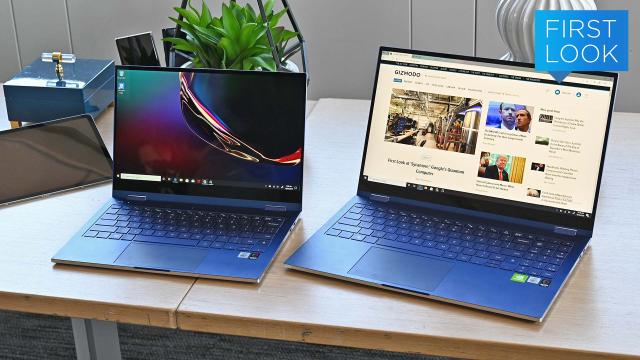Samsung knows that its recent laptops haven’t quite made the impact it wanted, so for its next batch of notebooks, Samsung is trying something new: borrowing the QLED display tech used on Samsung’s high-end TVs and putting them on the upcoming Galaxy Book Flex and Galaxy Book Ion.
Samsung claims this is the first time any company has put QLED tech on a laptop, and with its new displays, Samsung says its laptops can deliver peak brightness of up to 600 nits (most laptops top out at around 300 or 350 nits).
In person, the difference is obvious. When compared side-by-side with a Samsung Notebook 9 from last year, the Galaxy Book Flex’s display was noticeably brighter and more vibrant. However, I do have to mention that in order to get the Galaxy Book Flex’s full 600 nits of brightness, you have to enable to separate outdoor mode.
Sporting a gorgeous blue finish, aluminium chassis, and a 360-degree 2-in-1 hinge, the Galaxy Book Flex is the more premium of the pair. The Galaxy Book Flex comes with a range of 10th-gen Intel Ice Lake processors, up to 16GB of RAM, and 1TB NVMe SSDs.
However, QLED screens weren’t the only piece of tech Samsung borrow from its other gadget divisions, as the Galaxy Book Flex features a built-in S Pen stylus from Samsung’s Galaxy Note line of phones. The Galaxy Book Flex and Ion also come with some more smartphone-centric additions thanks to a dedicated fingerprint sensor for fast and secure biometric logins, and a wireless charging pad located underneath the system’s touchpad.
It’s sort of weird choice because that means you can’t wirelessly charge a gadget and use the touchpad at the same time, and to even turn on the wireless charger, you need to disable the touchpad using a keyboard shortcut. Samsung says the reason for this is because the Galaxy Book Flex’s metal body blocks wireless charging, which is true, but doesn’t address the issue, especially when it comes to the Galaxy Book Ion which sports a plastic body.
Speaking of the Galaxy Book Ion, while it’s just a standard clamshell laptop, what it lacks in flexibility it makes up for in portability, as the 13-inch model weighs under a kilogram (0.97 kg versus 1.15 kg for the 13-inch Galaxy Book Flex). However, the Galaxy Book Ion also comes with slightly reduced performance thanks to a range of Intel 10th-gen Comet Lake processors instead of Ice Lake-based chips.
Thankfully, both the 13-inch and 15-inch versions of both systems come with a healthy selection of ports which includes one Thuderbolt 3 port, two standard USB-A 3.0 ports, a full-size HDMI port, and a microSD card slot.
And if you need an extra bit of graphics performance, the 15-inch models can be configured with optional Nvidia MX250 discrete graphics, instead of standard Intel UHD graphics, or the Intel Iris Plus graphics available on Galaxy Book Flex.
Unfortunately, it’s going to be a long time until Samsung’s new laptops actually it the market, with Samsung only saying that the Galaxy Book Flex and Galaxy Book Ion will be available sometime in the first half of 2020.
